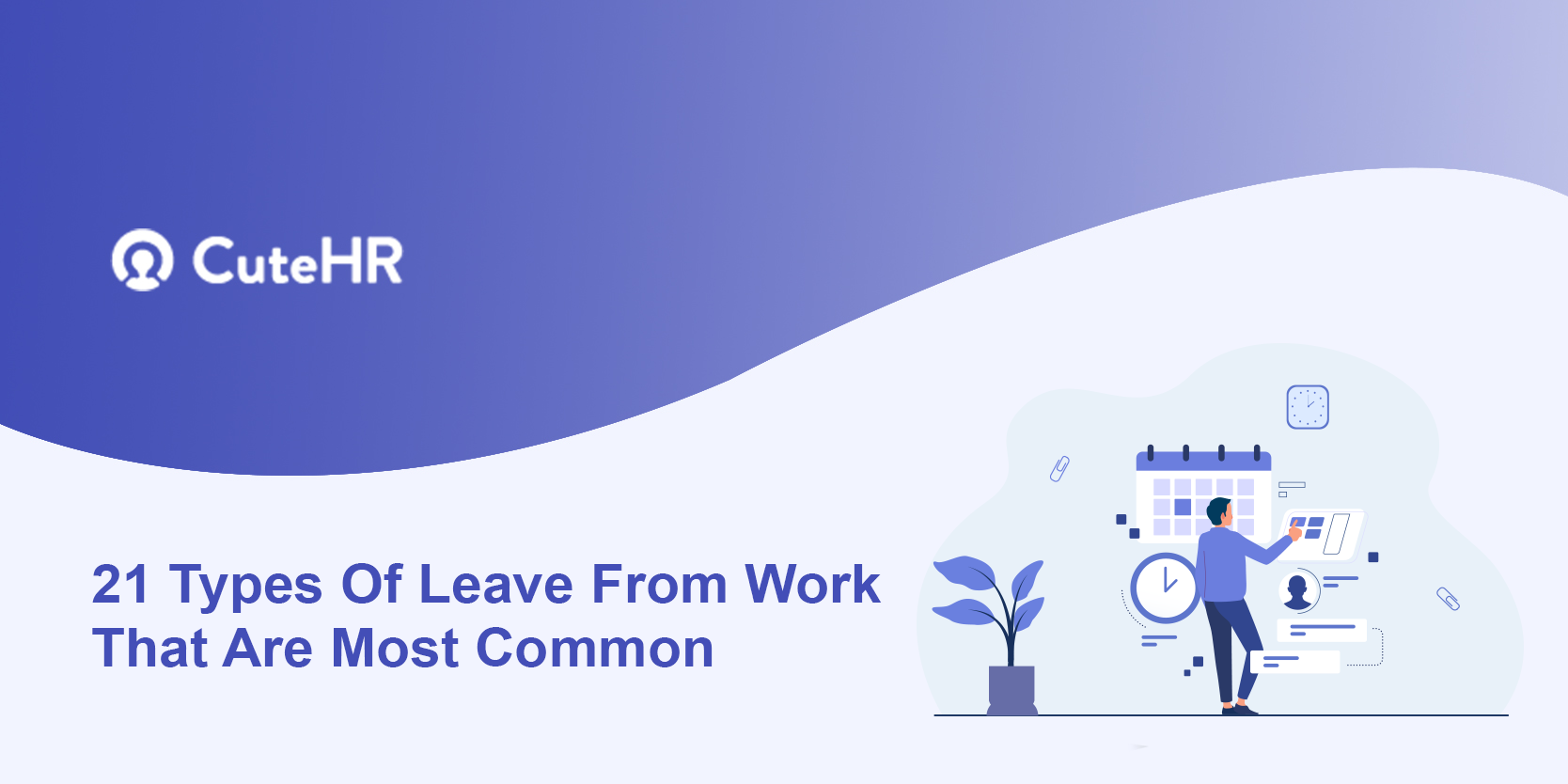17 Jul

Did you know? 52 % of small business owners feel employee absences influence their company. Many organization’s leave policies consist of informing their employees about their paid leave days and national holidays.
However, leave rules are more significant than you would think. Most applicants who a firm is recruiting will inquire about the organization’s leave policy. Aside from the number of leave, potential workers want to know what types of leaves the organization provides for various requirements and crises.
In this blog, we’ll look at the several types of leave of absence that every firm must offer to its employees.
Table of Contents
What Is Leave From Work?
Employees who are entitled to leave by law or contract may take time off work during ordinarily normal working hours. The important thing to understand is that leave comes in numerous forms and degrees of entitlement.
Why Does Your Company Need a Leave Policy?
A leave policy enables you to establish the number of leaves available to your employees, the sorts of leaves available to them, and how to apply for leaves. With a leave policy, you can assure them that you will offer them the necessary time off to address any concerns they may have or to vacation, recoup from an illness, celebrate their festivals, cope with life events, or simply rest.
How Should a Company Handle an Employee’s Leave?
Managing an employee’s leave is mostly a coordination issue. Handling an employee’s leave consists of five phases:-
- Determine the laws that apply.
- Examine your organization’s policies, processes, and practices.
- Approve or deny the leave request, and record the procedure.
- As the scenario develops, take action.
- Maintain a continual evaluation
Types Of Leave From Work That Are Most Common
In general, you can find the following types of leaves:
1. Annual Leave
Vacation leave is a type of leave not required by federal law in the United States; nonetheless, most firms do give paid vacation leave to their employees. This varies widely across states as well. Paid time off (PTO) can be approached in three ways:
- Unlimited PTO (an endless amount of days, which is becoming more common as employees strive for a better work/life balance).
- Accrual bank (Days are accrued on a monthly or quarterly basis)
- Annual allocation (a set number of days per year)
2. Parental Leave
Sometimes parental leave is separated into maternity and paternity leave. However, organizations are rapidly replacing this with the more inclusive term “all-inclusive parental leave.”
Many companies in many states are not legally compelled to provide paid maternity leave, but the FMLA does provide every woman with the right to up to 12 weeks of unpaid absence for this purpose (including adoption).
Some European countries provide significantly more generous maternity leave than others. Estonia, for instance, allows female employees to stay at home and care for their newborn kids for up to 18 months at no cost. In the meanwhile, Japan provides new dads with up to 30 weeks of paid parental leave equal to their income rate.
Only eight states in the United States provide dads and mothers with partially compensated parental leave (California, New York, New Jersey, Washington, Rhode Island, Oregon, Massachusetts, and Connecticut).
3. Family and Medical Leave (FMLA)
Employers with over 50 employees are entitled to the FMLA. It allows up to 12 weeks of leave per year for an employee’s or an employee’s immediate family member’s serious sickness or for an employee to help an immediate family member for qualifying exigencies relating to military duty.
FMLA leave is applicable in a variety of situations, including:
- An employee’s newborn child’s birth and care
- Taking care of a seriously ill family member
- Employees who are unable to work due to a serious medical condition can take medical leave.
4. Sick Leave
Sick leave is time off granted by the employer to employees to allow them to recuperate from illness and care for their health. Sick days are essential for allowing employees to relax without fear of losing compensation. Sick leave is a legal necessity in several nations to ensure an employee’s health.
Companies must give their employees 15 days of sick leave every year. You must, however, be flexible with your sick leave policies and enable employees to take longer ones if they have serious health difficulties.
Many firms allow sick leave that has not been used by the end of the year to be carried over to the next year. However, it is critical that you request that your staff take the day off if they are ill.
5. Public Holidays
The government designates some days as public holidays. Every institution, including schools, banks, government offices, and even private businesses, must observe such holidays.
Independence Day, Memorial Day, Labor Day, bank holidays, and any nationally recognized day, such as the death of a significant leader of the country, are examples of public holidays.
Include these leaves in your leave policy by researching the holidays that your country’s government requires.
6. Bereavement Leave
After the loss of a loved one, an employee takes bereavement or funeral leave (usually a relative or close friend). This is often the amount of time required for the employee to attend the funeral and recuperate from their immediate sadness.
It is frequently mistaken with compassionate leave, which entails taking time off to care for an ill family or someone who is reliant on you.
In the United States, bereavement leave is not required by law. However, some firms have an internal policy in place for this, while others accept it on a case-by-case basis. Employees are usually only eligible for bereavement leave if they work full-time and have been with the firm for a certain amount of time.
7. Religious Observance Leave
Religious observation leave is often unpaid time off offered to employees who choose to participate in religious festivals, customs, or festivities that are not recognized as official holidays. In the Australian state of Victoria, for example, persons professing the Jewish faith might earn up to 13 days off for religious observance.
It is vital to note that in most circumstances, these employees must produce proof of their beliefs in order for their religious observance leave to be authorized.
8. Unpaid Leave
Now, if your employee has exhausted their leave entitlement and is taking a break that does not qualify as special leave, such as maternity or bereavement leave, they can still take a leave with a pay drop.
Any absences taken during the year that are not compensated will result in a salary decrease for the employee. Make it clear how many leaves the employee has and how much pay is deducted every leave day taken outside of their qualifying leaves.
9. Sabbatical Leave
Simply described, sabbatical leaves are “time away from work” during which employees can pursue personal hobbies or take time off for medical and mental health reasons. Sabbaticals are longer leave periods, ranging from six months to a year.
Sabbaticals are frequently taken by employees at educational institutions, where academics may choose to take a vacation from teaching in order to do research on their subject.
Companies that have workers who have been with them for more than three years typically grant them a sabbatical leave to honor them for their dedication and hard work.
10. Military Leave
Those who do certain sorts of active or inactive service in the National Guard or as a Reserve in the Armed Forces are eligible for fully compensated leave. The Uniformed Services Employment and Reemployment Rights Act was also enacted to ensure that employers give reemployment to people who serve in the military or the National Guard.
11. Time Off in Lieu (TOIL)
TOIL is a compensation program that several organizations have implemented. Instead of getting more money, an employee might accept a defined period of overtime hours worked as extra leave time.
For example, if an employee is scheduled to work 40 hours a week but works 45, they are entitled to an additional five hours off “in lieu.”
Employees in organizations using TOIL systems are more optimistic about performing over time, resulting in increased production. This is also an excellent method of appropriately compensating staff without placing a firm under financial strain.
12. Protest Time Off
People in more democratic states of America (such as San Francisco, California, and New York) are more likely to reject government laws and decisions.
As a result, when a large demonstration arises, an employee may choose to take time off from work to show their support and rally for what they believe in. Many Silicon Valley companies have made protest time off part of their normal employee perks.
13. Jury Duty Leave
According to the National Center for State Courts (NCSC), 32 million individuals are summoned for jury duty each year. 1.5 million of them are chosen to serve. There is no Federal legislation requiring companies to pay employees for jury duty leave, while several states require this of their organizations.
Employees in the Uk must be provided time off to serve on juries. Although no law forces companies to pay their employees, many do.
14. Leave Due to Inclement Weather
Certain weather conditions make getting to work exceedingly difficult, risky, and occasionally impossible. Heavy snow, a hurricane, or sudden floods are examples of such situations. Many employees will need to take time off during these severe conditions. If the employee has unused paid leave, they may be able to take this time off as part of their yearly leave.
Employees in certain firms are given days off (up to 60 to 90 days) but are forced to make up that time afterward. They must submit an official letter, known as a Bad Weather Leave Letter, requesting the leave and specifying the type of adverse weather situation.
15. Voting Leave
Voting leave is defined as time off on official election days to ensure that everyone has an equal chance to vote. While federal law does not require companies to give paid or unpaid leave for employees to vote, state laws differ.
Many jurisdictions, like California and New York, require businesses to pay for a minimum of one hour of voting time for their employees.
16. Study Leave
When an employee takes study leave, it is to enhance their education, either through official means such as attending university or by obtaining new skills in another method. Although this form of leave is not included in many companies’ benefits packages, it is typically offered on a case-by-case basis at the discretion of the employer.
Employees are more likely to be given study leave if they can demonstrate how their new abilities will assist them at work and hence aid the firm.
17. Privilege Leave
As the name implies, these types of employment leaves are earned as part of working for the company for a set amount of time. These are paid leaves that may only be utilized with prior notice.
These leaves can be cashed in or carried forward for a period of three years. This form of leave can only be used three times each year.
18. Leaves With Half Pay
Not all businesses allow these types of leaves; however, most government organizations do, with employees being able to take up to 20 days of leave and receiving a half-day wage for each day of leave taken.
Employees are only eligible for these leaves after working for the firm for a specified amount of time.
19. Compensatory Leave
This is a type of leave for the employees who have worked more hours than needed and may be entitled to compensatory time off. Ensure that any employee who has put in additional hours or has gone to work on days they were off (such as Saturday) is given a compensatory day off, sometimes known as a “comp off.”
Compensatory time-off must be automatically recorded in your backend, and workers must be alerted that they have earned an extra day of leave for the hours worked.
20. Mandatory Leave
The Americans with Disabilities Act (ADA) and the Family Medical Leave Act govern mandatory leave at the federal level (FMLA). Employees may be allowed for up to 12 workweeks off without pay under the FMLA. At the conclusion of that period, they must usually be returned to their previous job or put in a comparable capacity.
It should be noted that various states may have varying obligatory leave rules. Employers may also be required to grant leave as part of collective bargaining agreements with their employees’ unions.
21. Voluntary Leave
Voluntary leave is a benefit provided to employees. As a result, it is often left to the employer’s decision and does not normally provide the same work security as the FMLA.
Businesses that opt to provide this benefit may wish to alter their business rules or employee handbooks to include particular voluntary leave requirements, such as who qualifies and who does not.
How Can HR Software Keep Track Of Types Of Leave?
With so many different types of leaves, how can you keep track of them all while still prioritizing employee data and accuracy? HR software may hold the solution.
CuteHR, for example, provides a calendar view of all forms of leaves, when employees are in and out of the office, and which types of leaves are being taken at any particular time.
Furthermore, your firm may specify certain sorts of leave (such as a duvet day or a self-care day) that can be monitored from the convenience of CuteHR’s dashboard.
Finally, your team can rapidly produce leave reports. You may track it across departments to get a complete picture of prospective absence in your organization.
What Do You Tell Employees Who Use Too Much Time Off?
There are several reasons why employees can take advantage of your type of leave policies. Employees who are disengaged from their work and who routinely take Mondays and Fridays off should be avoided. Make it plain to your employee that you cannot run a successful firm without their assistance.
Inform your staff that you care about their well-being and wish to assist them if doing so will be beneficial. Employees must understand what can and cannot be changed in their positions. This means that essential tasks (those functions that cannot be omitted or modified without significantly affecting the job) must be stated in your job descriptions.
Which Types Of Leave Should You Include In Your Absence Policy?
In a nutshell, all of them. Err on the side of caution and include as many forms of leave as feasible in your absence policy if in doubt (be sure to stay if some types of leave are not permitted). Of course, you may update your policy when your company’s circumstances change. When laws change, you must modify your absence policy.
Wrapping It Up
HR professionals and company executives must be aware of the many types of leaves of absence. This allows them to guarantee that employees feel appreciated and secure in their jobs.
It is critical to evaluate and incorporate all important forms of leave when developing your policy. It will assist your firm in being compliant and competitive in an ever-changing environment.
Frequently Asked Questions (FAQs)
How many leaves can an employee take?
Employee leave entitlement is referred to as earned leaves or EL under the Factories Act, whereas entitlement is referred to as privilege leaves or PL under the Shops and Establishments Act.
According to the Factories Act, a single earned leave is provided every 20 working days, for a total of 18 leaves each year.
What is casual leave?
Casual Leave, or CL, is granted to a qualified employee who is unable to report to work due to an unexpected circumstance. It is also possible to use casual leave if an employee needs some days off for personal reasons but not for vacation.












Himani